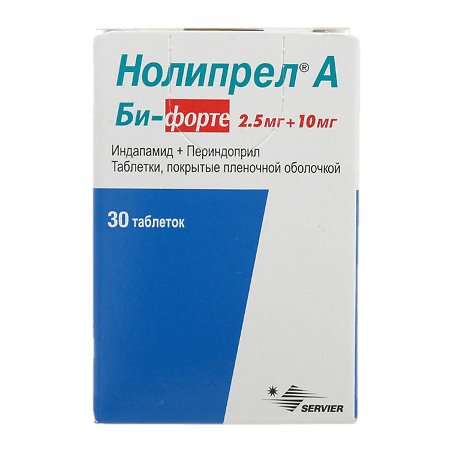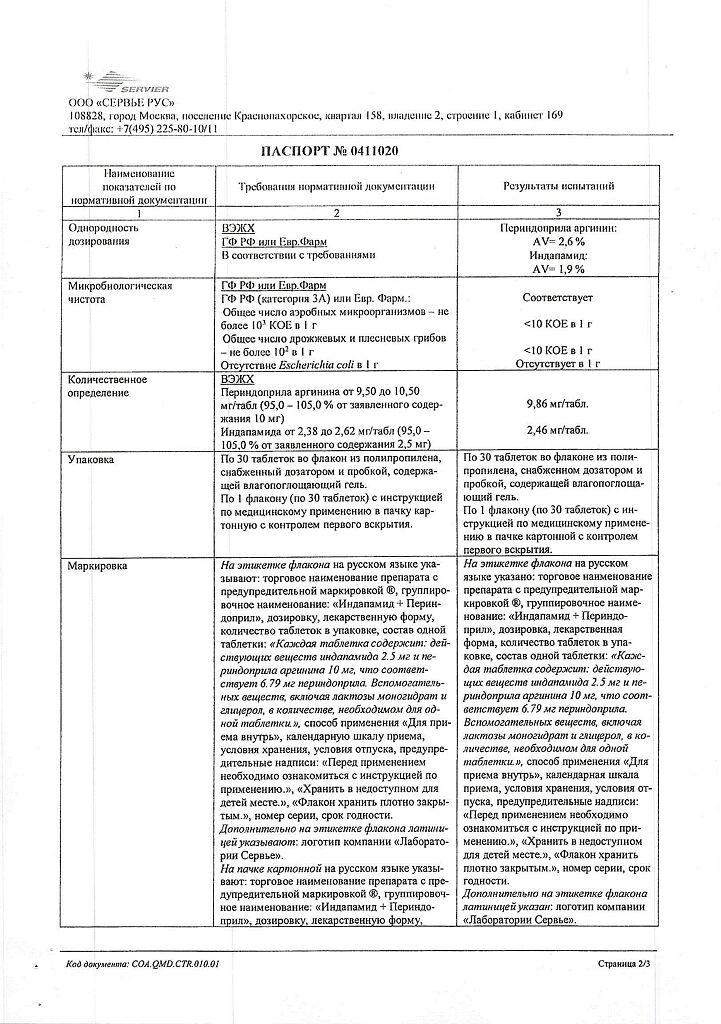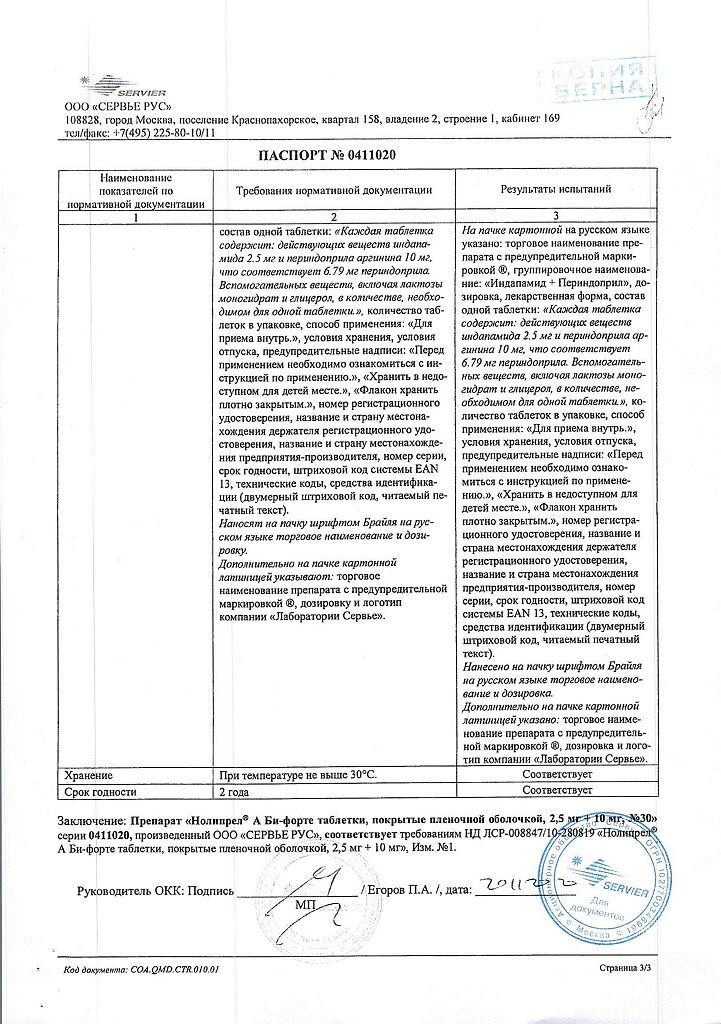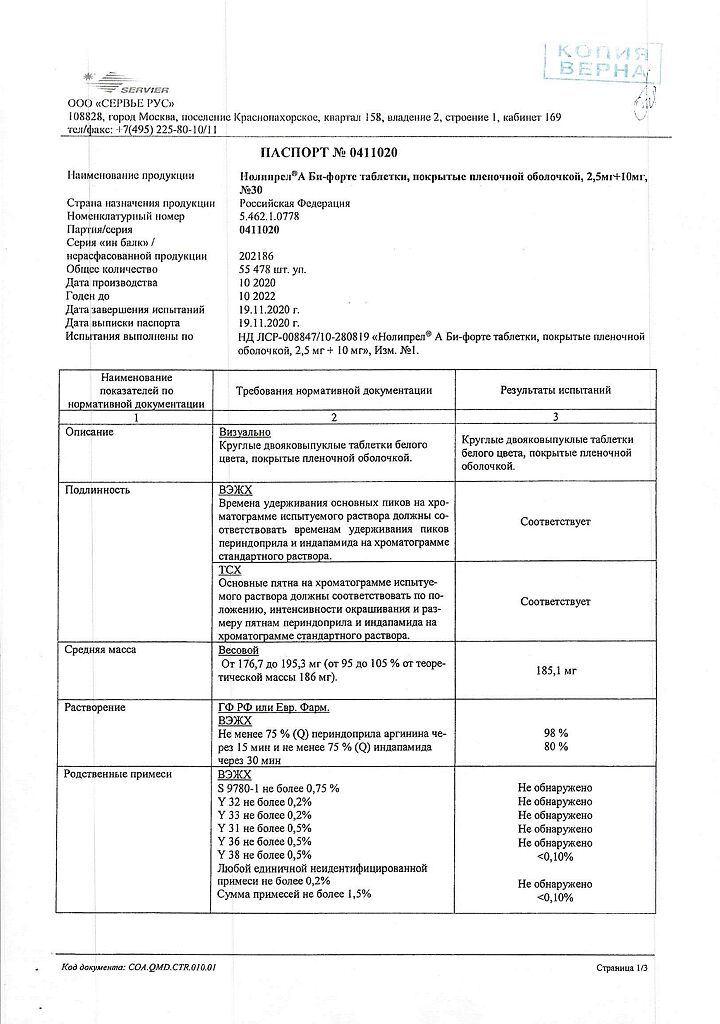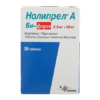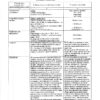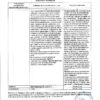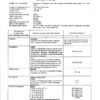No products in the cart.
Noliprel A Bi-forte, 10 mg+2, 5 mg 30 pcs.
€24.17 €20.14
Description
Noliprel ® A Bi-Forte is a combined preparation containing perindopril arginine and indapamide. The pharmacological properties of Noliprel® A Bi-Forte combine the individual properties of each of its active ingredients.
1. Mechanism of Action
Noliprel ® A Bi-forte
The combination of perindopril arginine and indapamide enhances the antihypertensive effects of each.
Perindopril
Perindopril is an inhibitor of the enzyme that converts angiotensin I to angiotensin II (ACE inhibitor). ACE, or kininase II, is an exopeptidase that both converts angiotensin I into the vasoconstrictor angiotensin II and degrades bradykinin, which has a vasodilator effect, into an inactive heptapeptide. As a result, perindopril:
– reduces aldosterone secretion;
– by the principle of negative feedback it increases plasma renin activity;
– with long-term use, it decreases RPS, which is mainly due to the effect on the vessels in the muscles and kidneys. These effects are not accompanied by retention of sodium ions or fluid or development of reflex tachycardia.
Perindopril normalizes myocardial function by reducing preload and postload.
In a study of hemodynamic parameters in patients with chronic heart failure (CHF), it was found:
– decreased filling pressures in the left and right ventricles of the heart;
– decreased PPSS;
– increased cardiac output and increased cardiac index;
– increased muscular peripheral blood flow.
Indapamide
Indapamide belongs to the group of sulfonamides; its pharmacological properties are similar to thiazide diuretics. Indapamide inhibits reabsorption of sodium ions in cortical segment of Genle loop, which leads to increase of renal excretion of sodium ions, chlorine and to a lesser extent potassium and magnesium ions, increasing diuresis and reducing BP.
2. Antihypertensive effects
Noliprel® A Bi-forte
Noliprel® A Bi-Forte has dose-dependent antihypertensive effects, both on BP and BP in standing and lying position. The antihypertensive effect of the drug is maintained for 24 hours. Stable therapeutic effect develops in less than 1 month from the start of therapy and is not accompanied by tachycardia. Discontinuation of therapy does not cause withdrawal syndrome.
Noliprel ® A Bi-forte decreases the degree of left ventricular hypertrophy (LVH), improves arterial elasticity, decreases PPS, does not affect lipid metabolism (total cholesterol, HDL and LDL cholesterol, triglycerides).
The effect of perindopril and indapamide combination on HTLV compared with enalapril has been proven. In patients with arterial hypertension and HTLD treated with perindopril erbumin 2 mg (equivalent to 2.5 mg perindopril arginine)/indapamide 0.625 mg or enalapril at a dose of 10 mg once daily, and when the perindopril erbumin dose was increased to 8 mg (equivalent to 10 mg of perindopril arginine) and indapamide to 2.5 mg, or enalapril to 40 mg once daily, a more significant reduction in left ventricular mass index (LVMI) was noted in the perindopril/indapamide group compared to the enalapril group. The most significant effect on BMI was noted with perindopril erbumin 8 mg/indapamide 2.5 mg.
There was also a more pronounced antihypertensive effect on combined therapy with perindopril and indapamide compared with enalapril.
Perindopril
Perindopril is effective in therapy of arterial hypertension of any severity.
The antihypertensive effect of the drug reaches the maximum 4-6 hours after a single oral dose and lasts for 24 hours. 24 hours after the drug administration there is a significant (about 80%) residual inhibition of ACE.
Perindopril has antihypertensive effect in patients with both low and normal plasma renin activity.
The concomitant administration of thiazide diuretics increases the severity of antihypertensive effect. In addition, combination of ACE inhibitor and thiazide diuretic also leads to decrease of risk of hypokalemia during diuretic therapy.
Indapamide
The antihypertensive effect is seen when the drug is used in doses with minimal diuretic action.
The antihypertensive effect of indapamide is associated with improvement of elastic properties of large arteries and reduction of PPS.
Indapamide decreases HDL, does not influence plasma lipid concentrations: triglycerides, total cholesterol, LDL cholesterol, HDL; carbohydrate metabolism (including in patients with concomitant diabetes mellitus).
Pharmacokinetics
Noliprel ® A Bi-forte
. The combined use of perindopril and indapamide does not alter their pharmacokinetic characteristics compared with the separate administration of these agents.
Perindopril
Perindopril is rapidly absorbed when taken orally. Cmax in plasma is reached 1 h after oral administration. T1/2 is 1 h. Perindopril has no pharmacological activity. Approximately 27% of the total amount of perindopril taken orally enters the bloodstream as the active metabolite, perindoprilate.
In addition to perindoprilat, 5 other metabolites with no pharmacological activity are formed. Cmax of perindoprilat in blood plasma is reached 3-4 hours after oral administration. Food intake slows down the conversion of perindopril to perindoprilat, thus affecting bioavailability. Therefore, the drug should be taken once a day, in the morning, before meals.
There is a linear dependence of plasma concentration of perindopril on its dose. The Vd of unbound perindoprilat is approximately 0.2 L/kg. Binding of perindoprilat to plasma proteins, mainly to ACE, depends on the concentration of perindopril and is about 20%.
Perindoprilat is excreted by the kidneys. The effective T1/2 unbound fraction is about 17 h, the equilibrium state is reached within 4 days.
The excretion of perindoprilat is delayed in the elderly and in patients with cardiac and renal insufficiency.
The dialysis clearance of perindoprilat is 70 ml/min.
The pharmacokinetics of perindopril is altered in patients with cirrhosis: its hepatic clearance is reduced by half. However, the amount of perindoprilat produced is not decreased, which does not require dose adjustment (see “Dosage and administration” and “Special indications”).
Indapamide
Indapamide is rapidly and completely absorbed from the gastrointestinal tract.
The Cmax of indapamide in plasma is observed 1 h after oral administration.
The binding to plasma proteins is 79%.
T1/2 is 14-24 h (mean 18 h). Reuptake of the drug does not lead to its cumulation in the body. It is eliminated mainly by the kidneys (70% of the administered dose) and through the intestine (22%) in the form of inactive metabolites.
The pharmacokinetics of the drug does not change in patients with renal failure.
Indications
Indications
Essential hypertension (patients who require therapy with perindopril at a dose of 10 mg and indapamide at a dose of 2.5 mg).
Pharmacological effect
Pharmacological effect
Noliprel® A Bi-forte is a combination drug containing perindopril arginine and indapamide. The pharmacological properties of the drug Noliprel® A Bi-forte combine the individual properties of each of its active components.
1. Mechanism of action
Noliprel® A Bi-forte
The combination of perindopril arginine and indapamide enhances the antihypertensive effect of each of them.
Perindopril
Perindopril is an inhibitor of the enzyme that converts angiotensin I to angiotensin II (ACE inhibitor). ACE, or kininase II, is an exopeptidase that carries out both the conversion of angiotensin I into the vasoconstrictor substance angiotensin II, and the destruction of bradykinin, which has a vasodilatory effect, into an inactive heptapeptide. As a result, perindopril:
– reduces the secretion of aldosterone;
– according to the principle of negative feedback, it increases the activity of renin in the blood plasma;
– with long-term use, it reduces the peripheral vascular resistance, which is mainly due to the effect on the vessels in the muscles and kidneys. These effects are not accompanied by sodium or fluid retention or the development of reflex tachycardia.
Perindopril normalizes myocardial function, reducing preload and afterload.
When studying hemodynamic parameters in patients with chronic heart failure (CHF), it was revealed:
– decrease in filling pressure in the left and right ventricles of the heart;
– decrease in OPSS;
– increased cardiac output and increased cardiac index;
– increased muscle peripheral blood flow.
Indapamide
Indapamide belongs to the group of sulfonamides; its pharmacological properties are similar to thiazide diuretics. Indapamide inhibits the reabsorption of sodium ions in the cortical segment of the loop of Henle, which leads to an increase in the excretion of sodium, chlorine and, to a lesser extent, potassium and magnesium ions by the kidneys, thereby increasing diuresis and reducing blood pressure.
2. Antihypertensive effect
Noliprel® A Bi-forte
Noliprel® A Bi-forte has a dose-dependent antihypertensive effect on both DBP and SBP in the standing and lying position. The antihypertensive effect of the drug lasts for 24 hours. A stable therapeutic effect develops less than 1 month from the start of therapy and is not accompanied by tachycardia. Stopping treatment does not cause withdrawal syndrome.
Noliprel® A Bi-forte reduces the degree of left ventricular hypertrophy (LVH), improves arterial elasticity, reduces peripheral vascular resistance, and does not affect lipid metabolism (total cholesterol, HDL and LDL cholesterol, triglycerides).
The effect of using a combination of perindopril and indapamide on LVG in comparison with enalapril has been proven. In patients with arterial hypertension and LVH who were treated with perindopril erbumine 2 mg (equivalent to 2.5 mg perindopril arginine)/indapamide 0.625 mg or enalapril 10 mg once daily, and with an increase in the dose of perindopril erbumine to 8 mg (equivalent to 10 mg perindopril arginine) and indapamide up to 2.5 mg, or enalapril up to 40 mg once a day, a more significant decrease in left ventricular mass index (LVMI) was noted in the perindopril/indapamide group compared with the enalapril group. In this case, the most significant effect on LVMI was observed with the use of perindopril erbumine 8 mg/indapamide 2.5 mg.
A more pronounced antihypertensive effect was also noted during combination therapy with perindopril and indapamide compared to enalapril.
Perindopril
Perindopril is effective in the treatment of arterial hypertension of any severity.
The antihypertensive effect of the drug reaches its maximum 4–6 hours after a single oral dose and persists for 24 hours. 24 hours after taking the drug, a pronounced (about 80%) residual ACE inhibition is observed.
Perindopril has an antihypertensive effect in patients with both low and normal plasma renin activity.
The simultaneous administration of thiazide diuretics increases the severity of the antihypertensive effect. In addition, the combination of an ACE inhibitor and a thiazide diuretic also reduces the risk of hypokalemia while taking diuretics.
Indapamide
The antihypertensive effect occurs when the drug is used in doses that have a minimal diuretic effect.
The antihypertensive effect of indapamide is associated with an improvement in the elastic properties of large arteries and a decrease in peripheral vascular resistance.
Indapamide reduces LVG, does not affect the concentration of lipids in the blood plasma: triglycerides, total cholesterol, LDL cholesterol, HDL cholesterol; carbohydrate metabolism (including in patients with concomitant diabetes mellitus).
Pharmacokinetics
Noliprel® A Bi-forte
The combined use of perindopril and indapamide does not change their pharmacokinetic characteristics compared to the separate administration of these drugs.
Perindopril
When taken orally, perindopril is rapidly absorbed. Cmax in blood plasma is achieved 1 hour after oral administration. T1/2 is 1 hour. Perindopril has no pharmacological activity. Approximately 27% of the total amount of perindopril taken orally enters the bloodstream in the form of an active metabolite, perindoprilate.
In addition to perindoprilate, 5 more metabolites are formed that do not have pharmacological activity. Cmax of perindoprilate in blood plasma is achieved 3–4 hours after oral administration. Eating slows down the conversion of perindopril to perindoprilat, thereby affecting bioavailability. Therefore, the drug should be taken once a day, in the morning, before meals.
There is a linear relationship between the concentration of perindopril in the blood plasma and its dose. The Vd of unbound perindoprilate is approximately 0.2 l/kg. The association of perindoprilate with plasma proteins, mainly with ACE, depends on the concentration of perindopril and is about 20%.
Perindoprilat is excreted from the body by the kidneys. The effective T1/2 of the unbound fraction is about 17 hours, the equilibrium state is reached within 4 days.
The elimination of perindoprilate is slowed down in old age, as well as in patients with heart and renal failure.
The dialysis clearance of perindoprilate is 70 ml/min.
The pharmacokinetics of perindopril is changed in patients with liver cirrhosis: its hepatic clearance is reduced by 2 times. However, the amount of perindoprilate formed does not decrease, which does not require dose adjustment (see “Dosage and Administration” and “Special Instructions”).
Indapamide
Indapamide is quickly and completely absorbed from the gastrointestinal tract.
Cmax of indapamide in blood plasma is observed 1 hour after oral administration.
Connection with blood plasma proteins – 79%.
T1/2 is 14–24 hours (average 18 hours). Repeated administration of the drug does not lead to its accumulation in the body. It is excreted mainly by the kidneys (70% of the administered dose) and through the intestines (22%) in the form of inactive metabolites.
The pharmacokinetics of the drug does not change in patients with renal failure.
Special instructions
Special instructions
Noliprel® A Bi-forte
Lithium preparations
The simultaneous use of a combination of perindopril and indapamide with lithium preparations is not recommended (see “Interactions”).
Renal dysfunction
Therapy with Noliprel® A Bi-forte is contraindicated in patients with moderate and severe renal failure (Cl creatinine® A Bi-forte should be discontinued. In the future, combination therapy can be resumed using low doses of a combination of perindopril and indapamide, or the drugs can be used in monotherapy.
Such patients require regular monitoring of the content of potassium ions and creatinine in the blood serum – 2 weeks after the start of therapy and then every 2 months. Renal failure occurs more often in patients with severe chronic heart failure or underlying renal impairment, incl. with renal artery stenosis.
Noliprel® A Bi-forte is not recommended for patients with bilateral renal artery stenosis or stenosis of the artery of a single functioning kidney.
Arterial hypotension and water-electrolyte imbalance
Hyponatremia is associated with a risk of sudden development of arterial hypotension (especially in patients with renal artery stenosis, including bilateral). Therefore, when monitoring patients, attention should be paid to possible symptoms of dehydration and decreased plasma electrolytes, for example, after diarrhea or vomiting. Such patients require regular monitoring of blood plasma electrolyte levels.
In case of severe arterial hypotension, intravenous administration of 0.9% sodium chloride solution may be required.
Transient arterial hypotension is not a contraindication for continued therapy. After restoration of blood volume and blood pressure, therapy can be resumed using low doses of a combination of perindopril and indapamide, or the drugs can be used as monotherapy.
Potassium content
The combined use of perindopril and indapamide does not prevent the development of hypokalemia, especially in patients with diabetes mellitus or renal failure. As with the use of other antihypertensive drugs in combination with a diuretic, regular monitoring of the content of potassium ions in the blood plasma is necessary.
Excipients
It should be taken into account that the excipients of the drug include lactose monohydrate. Noliprel® A Bi-forte should not be prescribed to patients with hereditary galactose intolerance, lactase deficiency and glucose-galactose malabsorption.
Perindopril
Neutropenia/agranulocytosis
The risk of developing neutropenia while taking ACE inhibitors is dose-dependent and depends on the drug taken and the presence of concomitant diseases. Neutropenia rarely occurs in patients without concomitant diseases, but the risk increases in patients with impaired renal function, especially against the background of systemic connective tissue diseases (including systemic lupus erythematosus, scleroderma).
After discontinuation of ACE inhibitors, clinical signs of neutropenia disappear on their own.
Perindopril should be used with extreme caution in patients with systemic connective tissue diseases, while taking immunosuppressive drugs, allopurinol or procainamide and when used together, especially in patients with underlying renal impairment. Some patients developed severe infectious diseases, in some cases resistant to intensive antibiotic therapy. When prescribing perindopril to such patients, it is recommended to periodically monitor the number of leukocytes in the blood. Patients should report any signs of infectious diseases (eg, sore throat, fever) to their doctor.
Hypersensitivity/angioedema (Quincke’s edema)
When taking ACE inhibitors, incl. and perindopril, in rare cases, the development of angioedema of the face, extremities, lips, tongue, glottis and/or larynx may occur. If symptoms appear, taking Noliprel® A Bi-forte should be stopped immediately, and the patient should be observed until signs of edema disappear completely. If the swelling affects only the face and lips, it usually resolves on its own, although antihistamines may be used to treat symptoms.
Angioedema, accompanied by swelling of the larynx, can be fatal. Swelling of the tongue, glottis, or larynx can lead to airway obstruction. If such symptoms appear, you should immediately administer epinephrine (adrenaline) subcutaneously at a dilution of 1:1000 (0.3 or 0.5 ml) and/or ensure airway patency.
Patients with a history of angioedema not associated with taking ACE inhibitors may have an increased risk of developing it when taking drugs of this group (see “Contraindications”).
In rare cases, angioedema of the intestine develops during therapy with ACE inhibitors. In this case, patients experience abdominal pain as an isolated symptom or in combination with nausea and vomiting, in some cases without previous angioedema of the face and with normal activity of the C1 esterase enzyme. The diagnosis is made using computed tomography of the abdominal region, ultrasound, or at the time of surgery. Symptoms disappear after stopping ACE inhibitors. In patients with abdominal pain receiving ACE inhibitors, the possibility of developing angioedema of the intestine must be taken into account when making a differential diagnosis.
Anaphylactoid reactions during desensitization
There are isolated reports of the development of long-term life-threatening anaphylactoid reactions in patients receiving ACE inhibitors during desensitizing therapy with the venom of hymenoptera insects (bees, wasps). ACE inhibitors should be used with caution in patients with a history of allergies or a tendency to allergic reactions undergoing desensitization procedures. Prescription of an ACE inhibitor should be avoided in patients receiving immunotherapy with hymenoptera venom. However, an anaphylactoid reaction can be avoided by temporarily discontinuing the ACE inhibitor at least 24 hours before the start of the desensitization procedure.
Anaphylactoid reactions during LDL apheresis
In rare cases, life-threatening anaphylactoid reactions may occur in patients receiving ACE inhibitors during LDL apheresis using dextran sulfate. To prevent an anaphylactoid reaction, ACE inhibitor therapy should be temporarily discontinued before each apheresis procedure.
Hemodialysis
Anaphylactoid reactions have been reported in patients receiving ACE inhibitors during hemodialysis using high-flux membranes (eg, AN69®). Therefore, it is advisable to use a different type of membrane or use an antihypertensive agent of a different pharmacotherapeutic group.
Potassium-sparing diuretics and potassium supplements
As a rule, the combined use of perindopril and potassium-sparing diuretics, as well as potassium preparations and potassium-containing table salt substitutes is not recommended (see “Interactions”).
Cough
During therapy with an ACE inhibitor, a dry cough may occur. The cough persists for a long time while taking drugs of this group and disappears after their discontinuation. If a patient develops a dry cough, one should be aware of the possible connection of this symptom with taking an ACE inhibitor. If the doctor believes that ACE inhibitor therapy is necessary for the patient, the drug may be continued.
Children and teenagers
Noliprel® A Bi-forte should not be prescribed to children and adolescents under the age of 18 years due to the lack of data on the effectiveness and safety of the use of single drugs or combination therapy in patients in this age group.
Risk of arterial hypotension and/or renal failure (in patients with chronic heart failure, fluid and electrolyte imbalance, etc.)
In some pathological conditions, significant activation of the RAAS may be observed, especially with severe hypovolemia and a decrease in plasma electrolytes (due to a salt-free diet or long-term use of diuretics), in patients with initially low blood pressure, renal artery stenosis (including bilateral), chronic heart failure or cirrhosis of the liver with edema and ascites.
The use of ACE inhibitors causes blockade of the RAAS and therefore may be accompanied by a sharp decrease in blood pressure and/or an increase in the concentration of creatinine in the blood plasma, indicating the development of functional renal failure. These phenomena are more often observed when taking the first dose of the drug or during the first two weeks of therapy. Sometimes these conditions develop acutely. In such cases, when resuming therapy, it is recommended to use a combination of perindopril and indapamide at a lower dose and then gradually increase the dose.
Elderly patients
Before starting to take Noliprel® A Bi-forte, it is necessary to evaluate the functional activity of the kidneys and the content of potassium ions in the blood plasma. At the beginning of therapy, the dose of the drug is selected taking into account the degree of reduction in blood pressure, especially in the case of a decrease in blood volume and loss of electrolytes. Such measures help to avoid a sharp decrease in blood pressure.
Atherosclerosis
The risk of arterial hypotension exists in all patients, however, special care should be taken when using the drug in patients with coronary artery disease and cerebrovascular insufficiency. In such patients, treatment should begin with a low dose combination of perindopril arginine and indapamide.
Patients with renovascular hypertension
The treatment method for renovascular hypertension is revascularization. However, the use of ACE inhibitors has a beneficial effect in patients both awaiting surgery and in cases where surgery is not possible.
In patients with diagnosed or suspected renal artery stenosis, treatment should be initiated with lower doses of the combination of perindopril and indapamide. Some patients may develop functional renal failure, which disappears when Noliprel® A Bi-forte is discontinued.
Other risk groups
In patients with chronic heart failure (functional class IV according to the NYHA classification) and patients with type 1 diabetes (risk of spontaneous increase in potassium ions), treatment should begin with lower doses of the combination of perindopril and indapamide and under constant medical supervision.
Patients with arterial hypertension and coronary artery disease should not stop taking beta-blockers: the combination of perindopril and indapamide should be used in conjunction with beta-blockers.
Patients with diabetes mellitus
When prescribing Noliprel® A Bi-forte to patients with diabetes mellitus receiving oral hypoglycemic agents or insulin, regular monitoring of plasma glucose concentrations is necessary during the first month of therapy.
Ethnic differences
Perindopril, like other ACE inhibitors, apparently has a less pronounced hypotensive effect in patients of the Negroid race compared to representatives of other races. Perhaps this difference is due to the fact that patients with arterial hypertension of the Negroid race more often have low renin activity.
Surgery/general anesthesia
The use of ACE inhibitors in patients undergoing surgery under general anesthesia can lead to a significant decrease in blood pressure, especially when using general anesthetic agents that have an antihypertensive effect.
It is recommended to stop taking long-acting ACE inhibitors, incl. perindopril, 12 hours before surgery.
Aortic stenosis/mitral stenosis/hypertrophic cardiomyopathy
ACE inhibitors should be prescribed with caution to patients with left ventricular outflow obstruction and mitral stenosis.
Liver failure
In rare cases, cholestatic jaundice occurs while taking ACE inhibitors. As this syndrome progresses, fulminant liver necrosis develops, sometimes with death. The mechanism of development of this syndrome is unclear. If jaundice occurs while taking ACE inhibitors, the patient should consult a doctor. If there is a significant increase in the activity of liver enzymes while taking ACE inhibitors, you should stop taking Noliprel® A Bi-forte (see “Side effects”).
Anemia
Anemia can develop in patients after kidney transplantation or in patients on hemodialysis. In this case, the decrease in hemoglobin is greater, the higher its initial value. This effect does not appear to be dose-dependent, but may be related to the mechanism of action of ACE inhibitors.
Hyperkalemia
Hyperkalemia may develop during treatment with ACE inhibitors, incl. and perindopril. Risk factors for hyperkalemia are renal failure, impaired renal function, old age, diabetes mellitus, certain concomitant conditions (dehydration, acute decompensation of chronic heart failure, metabolic acidosis), concomitant use of potassium-sparing diuretics (such as spironolactone, eplerenone, triamterene, amiloride), as well as potassium supplements or potassium-containing food substitutes salts, as well as the use of other drugs that help increase the content of potassium ions in the blood plasma (for example, heparin) (especially in patients with reduced renal function). Hyperkalemia can lead to serious, sometimes fatal, heart rhythm disturbances. If combined use of the above drugs is necessary, treatment should be carried out with caution, against the background of regular monitoring of the content of potassium ions in the blood serum (see “Interaction”).
Indapamide
In the presence of liver dysfunction, taking thiazide and thiazide-like diuretics can lead to the development of hepatic encephalopathy. In this case, you should immediately stop taking Noliprel® A Bi-forte.
Photosensitivity
Cases of photosensitivity reactions have been reported while taking thiazide and thiazide-like diuretics (see “Side effects”). If a photosensitivity reaction develops while taking the drug, treatment should be discontinued. If it is necessary to continue diuretic therapy, it is recommended to protect the skin from exposure to sunlight or artificial UV rays.
Water and electrolyte balance
Content of sodium ions in blood plasma. Before starting treatment, it is necessary to determine the content of sodium ions in the blood plasma. While taking the drug, this indicator should be regularly monitored. All diuretics can cause hyponatremia, which sometimes leads to serious complications. Hyponatremia at the initial stage may not be accompanied by clinical symptoms, so regular laboratory monitoring is necessary. More frequent monitoring of sodium ion levels is indicated in elderly patients (see “Side effects” and “Overdose”).
Content of potassium ions in blood plasma. Therapy with thiazide and thiazide-like diuretics is associated with a risk of hypokalemia. Hypokalemia (less than 3.4 mmol/l) should be avoided in the following categories of high-risk patients: elderly patients, debilitated patients or those receiving concomitant drug therapy, patients with liver cirrhosis, peripheral edema or ascites, coronary artery disease, chronic heart failure. Hypokalemia in these patients enhances the toxic effect of cardiac glycosides and increases the risk of developing arrhythmia.
The high-risk group also includes patients with an increased QT interval, and it does not matter whether this increase is caused by congenital causes or the effect of drugs.
Hypokalemia, like bradycardia, contributes to the development of severe cardiac arrhythmias, especially pirouette-type arrhythmias, which can be fatal. In all the cases described above, regular monitoring of the content of potassium ions in the blood plasma is necessary. The first measurement of potassium ion content should be carried out within the first week from the start of therapy.
If hypokalemia is detected, appropriate treatment should be prescribed.
Content of calcium ions in blood plasma. Thiazide and thiazide-like diuretics reduce the excretion of calcium ions by the kidneys, leading to a slight and temporary increase in the content of calcium ions in the blood plasma. Severe hypercalcemia may be a consequence of previously undiagnosed hyperparathyroidism. Before studying the function of the parathyroid glands, you should stop taking diuretics.
Plasma glucose concentration
It is necessary to monitor blood glucose concentrations in patients with diabetes mellitus, especially in the presence of hypokalemia.
Uric acid
In patients with elevated concentrations of uric acid in the blood plasma, the frequency of gout attacks may increase during therapy.
Diuretics and kidney function
Thiazide and thiazide-like diuretics are fully effective only in patients with normal or slightly impaired renal function (plasma creatinine concentration in adult patients below 25 mg/l or 220 µmol/l). In elderly patients, Clcreatinine is calculated taking into account age, body weight and gender.
At the beginning of treatment with diuretics, patients due to hypovolemia and hyponatremia may experience a temporary decrease in glomerular filtration rate and an increase in the concentration of urea and creatinine in the blood plasma. This transient functional renal failure is not dangerous for patients with unchanged renal function, but its severity may increase in patients with renal failure.
Athletes
Indapamide may give a positive reaction during doping control.
Impact on the ability to drive a car or perform work that requires increased speed of physical and mental reactions. The action of the agents included in the drug Noliprel® A Bi-forte does not lead to impairment of psychomotor reactions. However, some patients may develop different individual reactions in response to a decrease in blood pressure, especially at the beginning of therapy or when other antihypertensive drugs are added to the therapy. In this case, the ability to drive vehicles or perform work that requires increased speed of physical and mental reactions may be reduced.
Active ingredient
Active ingredient
Indapamide, Perindopril
Composition
Composition
Active ingredients:
perindopril arginine 10 mg;
indapamide 2.5 mg;
Excipients:
lactose monohydrate – 142.66 mg;
magnesium stearate – 0.9 mg;
maltodextrin – 18 mg;
colloidal silicon dioxide anhydrous – 0.54 mg;
sodium carboxymethyl starch (type A) – 5.4 mg;
Film casing:
macrogol 6000 – 0.27828 mg; magnesium stearate – 0.2622 mg; titanium dioxide (E171) – 0.83902 mg; glycerol – 0.2622 mg; hypromellose – 4.3583 mg).
Pregnancy
Pregnancy
Pregnancy
Noliprel® A Bi-forte is contraindicated during pregnancy (see “Contraindications”).
If you are planning pregnancy or if it occurs while taking the drug, you should immediately stop taking the drug and prescribe other antihypertensive therapy. There have been no adequate controlled studies of ACE inhibitors in pregnant women. The limited available data on the effects of the drug in the first trimester of pregnancy indicate that the drug did not lead to malformations associated with fetotoxicity.
Noliprel® A Bi-forte should not be used in the first trimester of pregnancy. Noliprel® A Bi-forte is contraindicated in the second and third trimesters of pregnancy.
It is known that long-term exposure of the fetus to ACE inhibitors in the second and third trimesters of pregnancy can lead to disruption of its development (decreased renal function, oligohydramnios, delayed ossification of the skull bones) and the development of complications in the newborn (renal failure, arterial hypotension, hyperkalemia).
Long-term use of thiazide diuretics in the third trimester of pregnancy can cause hypovolemia in the mother and a decrease in uteroplacental blood flow, which leads to fetoplacental ischemia and fetal growth retardation. In rare cases, while taking diuretics shortly before birth, newborns develop hypoglycemia and thrombocytopenia.
If the patient received Noliprel® A Bi-forte during the second or third trimesters of pregnancy, it is recommended to perform an ultrasound of the newborn to assess the condition of the skull bones and kidney function.
In newborns whose mothers received therapy with ACE inhibitors, arterial hypotension may be observed, and therefore newborns should be under close medical supervision.
Breastfeeding period
Noliprel® A Bi-forte is contraindicated during breastfeeding.
It is not known whether perindopril is excreted in breast milk.
Indapamide is excreted in breast milk. Taking thiazide diuretics causes a decrease in the amount of breast milk or suppression of lactation. The newborn may develop hypersensitivity to sulfonamide derivatives, hypokalemia and kernicterus.
It is necessary to assess the significance of therapy for the mother and make a decision to stop breastfeeding or stop taking the drug.
Contraindications
Contraindications
Perindopril
hypersensitivity to perindopril and other ACE inhibitors;
history of angioedema (Quincke’s edema) associated with taking an ACE inhibitor;
hereditary/idiopathic angioedema;
bilateral renal artery stenosis or stenosis of the artery of a single kidney;
pregnancy;
breastfeeding period;
age under 18 years (efficacy and safety have not been established).
Indapamide
hypersensitivity to indapamide and other sulfonamides;
severe liver failure (including with encephalopathy);
hypokalemia;
simultaneous use with drugs that can cause pirouette-type arrhythmia (see “Interaction”);
pregnancy and breastfeeding (see “Use during pregnancy and breastfeeding”);
age under 18 years (efficacy and safety have not been established).
Noliprel® A Bi-forte
hypersensitivity to the excipients included in the drug;
severe renal failure (Cl creatinine
simultaneous use with potassium-sparing diuretics, potassium and lithium preparations, and in patients with increased levels of potassium ions in the blood plasma;
the presence of lactase deficiency, galactosemia or glucose-galactose malabsorption syndrome, lactose intolerance;
simultaneous use of drugs that prolong the QT interval (see “Interaction”);
due to the lack of sufficient clinical experience, the drug Noliprel® A Bi-forte should not be used in patients on hemodialysis, as well as in patients with untreated heart failure in the stage of decompensation;
age under 18 years (efficacy and safety have not been established).
With caution: systemic diseases of connective tissue (including systemic lupus erythematosus, scleroderma), therapy with immunosuppressants (risk of developing neutropenia, agranulocytosis), inhibition of bone marrow hematopoiesis, reduced blood volume (taking diuretics, salt-free diet, vomiting, diarrhea), coronary heart disease, cerebrovascular diseases, renovascular hypertension, diabetes diabetes, chronic heart failure (functional class IV according to the NYHA classification), hyperuricemia (especially accompanied by gout and urate nephrolithiasis), blood pressure lability, old age; hemodialysis using high-flux membranes (for example, AN69®) or desensitization, LDL apheresis, condition after kidney transplantation; Aortic valve stenosis/hypertrophic cardiomyopathy.
Side Effects
Side Effects
From the circulatory and lymphatic system: very rarely – thrombocytopenia, leukopenia/neutropenia, agranulocytosis, aplastic anemia, hemolytic anemia.
In certain clinical situations (patients after kidney transplantation, patients on hemodialysis), ACE inhibitors can cause anemia (see “Special Instructions”).
From the side of the central nervous system: often – paresthesia, headache, dizziness, vertigo; infrequently – sleep disturbance, mood lability; very rarely – confusion; unspecified frequency – fainting.
From the side of the organ of vision: often – visual impairment.
On the part of the hearing organ: often – tinnitus.
From the cardiovascular system: infrequently – a pronounced decrease in blood pressure, incl. orthostatic hypotension; very rarely – heart rhythm disturbances, incl. bradycardia, ventricular tachycardia, atrial fibrillation, as well as angina pectoris and myocardial infarction, possibly due to an excessive decrease in blood pressure in high-risk patients (see “Special Instructions”); unspecified frequency – pirouette-type arrhythmias (possibly fatal – see “Interaction” and “Special instructions”).
From the respiratory system, chest organs and mediastinum: often – during the use of ACE inhibitors, a dry cough may occur, which persists for a long time while taking drugs of this group and disappears after their withdrawal, shortness of breath; infrequently – bronchospasm; very rarely – eosinophilic pneumonia, rhinitis.
From the digestive system: often – dryness of the oral mucosa, nausea, vomiting, abdominal pain, epigastric pain, impaired taste perception, decreased appetite, dyspepsia, constipation, diarrhea; very rarely – pancreatitis; angioedema of the intestine, cholestatic jaundice; unspecified frequency – hepatic encephalopathy in patients with liver failure (see “Contraindications” and “Special instructions”).
From the skin and subcutaneous fat: often – skin rash, itching, maculopapular rash; uncommon – angioedema of the face, lips, extremities, mucous membrane of the tongue, vocal folds and/or larynx, urticaria (see “Special Instructions”), hypersensitivity reactions in patients predisposed to broncho-obstructive and allergic reactions; hemorrhagic vasculitis. In patients with acute form of systemic lupus erythematosus, the course of the disease may worsen. Very rarely – erythema multiforme, toxic epidermal necrolysis, Stevens-Johnson syndrome. Cases of photosensitivity reactions have been reported (see “Special Instructions”).
From the musculoskeletal system and connective tissue: often – muscle spasms.
From the urinary system: infrequently – renal failure; very rarely – acute renal failure.
From the reproductive system: infrequently – impotence.
General disorders and symptoms: often – asthenia; infrequently – increased sweating.
Laboratory indicators: rarely – hypercalcemia; unspecified frequency – an increase in the QT interval on the ECG (see “Interaction” and “Special Instructions”), an increase in the concentration of uric acid and glucose in the blood while taking the drug, an increase in the activity of liver enzymes, a slight increase in the concentration of creatinine in the urine and in the blood plasma, which occurs after discontinuation of therapy, more often in patients with renal artery stenosis, in the treatment of arterial hypertension with diuretics and in the case of renal failure, hypokalemia, especially significant for patients at risk (see “Special Instructions”); hyperkalemia, often transient; hyponatremia and hypovolemia, leading to dehydration and orthostatic hypotension.
Interaction
Interaction
Noliprel® A Bi-forte
1. Undesirable combination of drugs
Lithium preparations: with simultaneous use of lithium preparations and ACE inhibitors, a reversible increase in the content of lithium in the blood plasma and associated toxic effects may occur. Additional administration of thiazide diuretics may further increase lithium levels and increase the risk of toxicity. The simultaneous use of a combination of perindopril and indapamide with lithium preparations is not recommended. In the case of such therapy, regular monitoring of the lithium content in the blood plasma is necessary (see “Special Instructions”).
2. Combination of drugs requiring special attention
Baclofen: may enhance the hypotensive effect. Blood pressure and renal function should be monitored and, if necessary, dose adjustment of antihypertensive drugs is required.
NSAIDs, including high doses of acetylsalicylic acid (more than 3 g/day): simultaneous administration of ACE inhibitors and NSAIDs (acetylsalicylic acid in a dose that has an anti-inflammatory effect, COX-2 inhibitors and non-selective NSAIDs) may lead to a decrease in the antihypertensive effect. Concomitant use of ACE inhibitors and NSAIDs may lead to deterioration of renal function, including the development of acute renal failure and an increase in serum potassium, especially in patients with reduced renal function. Caution should be exercised when prescribing this combination, especially in elderly patients. Patients need to compensate for fluid loss and regularly monitor kidney function, both at the beginning of treatment and during treatment.
3. Combination of products that requires attention
Tricyclic antidepressants, antipsychotics (neuroleptics): drugs of these classes enhance the antihypertensive effect and increase the risk of orthostatic hypotension (additive effect).
GCS, tetracosactide: decreased antihypertensive effect (retention of fluid and sodium ions as a result of the action of GCS).
Other antihypertensive drugs: the antihypertensive effect may be enhanced.
Perindopril
1. Undesirable combination of drugs
Potassium-sparing diuretics (amiloride, spironolactone, triamterene, both as monotherapy and as part of combination therapy) and potassium supplements: during therapy with ACE inhibitors, as a rule, the potassium content in the blood serum remains within normal limits, but hyperkalemia may develop (rarely). Concomitant use of potassium-sparing diuretics (for example, spironolactone, triamterene, amiloride), potassium supplements and potassium-containing table salt substitutes can lead to a significant increase in the content of potassium ions in the blood serum, including death. If combined use of an ACE inhibitor and the above drugs is necessary (in case of confirmed hypokalemia), caution should be exercised and regular monitoring of potassium levels in the blood plasma and ECG parameters should be carried out.
2. Combination of drugs requiring special attention
Oral hypoglycemic agents (sulfonylureas) and insulin: The following effects have been reported for captopril and enalapril. ACE inhibitors may enhance the hypoglycemic effect of insulin and sulfonylureas in patients with diabetes mellitus. The development of hypoglycemia is very rare (due to an increase in glucose tolerance and a decrease in the need for insulin).
3. Combination of products that requires attention
Allopurinol, cytostatic and immunosuppressive drugs, corticosteroids (for systemic use) and procainamide: simultaneous use with ACE inhibitors may be accompanied by an increased risk of leukopenia.
Agents for general anesthesia: simultaneous use of ACE inhibitors and agents for general anesthesia may lead to an enhanced antihypertensive effect.
Diuretics (thiazide and loop): the use of diuretics in high doses can lead to hypovolemia, and the addition of perindopril to therapy can lead to arterial hypotension.
Gold preparations: when using ACE inhibitors, incl. perindopril, in patients receiving intravenous gold preparations (sodium aurothiomalate), a sympathocomplex was described, including facial flushing, nausea, vomiting, and arterial hypotension.
Indapamide
1. Combination of funds that requires special attention
Drugs that can cause torsades de pointes: due to the risk of hypokalemia, caution should be exercised when indapamide is co-administered with drugs that can cause torsades de pointes, for example, antiarrhythmics (quinidine, hydroquinidine, disopyramide, amiodarone, dofetilide, ibutilide, bretylium tosylate, sotalol), some antipsychotics (chlorpromazine, cyamemazine, levomepromazine, thioridazine, trifluoperazine), benzamides (amisulpride, sulpiride, sultopride, tiapride), butyrophenones (droperidol, haloperidol); other antipsychotics (pimozide), other drugs such as bepridil, cisapride, difemanil methyl sulfate, erythromycin IV, halofantrine, mizolastine, moxifloxacin, pentamidine, sparfloxacin, vincamine IV, methadone, astemizole, terfenadine. Concomitant use with the above drugs should be avoided; the risk of developing hypokalemia and, if necessary, correct it, monitor the QT interval.
Drugs that can cause hypokalemia: amphotericin B (iv), gluco- and mineralocorticosteroids (when administered systemically), tetracosactide, laxatives that stimulate gastrointestinal motility: increased risk of hypokalemia (additive effect). It is necessary to monitor the content of potassium ions in the blood plasma and, if necessary, correct it. Particular attention should be paid to patients concomitantly receiving cardiac glycosides. Laxatives that do not stimulate gastrointestinal motility should be used.
Cardiac glycosides: hypokalemia enhances the toxic effect of cardiac glycosides. With the simultaneous use of indapamide and cardiac glycosides, the content of potassium in the blood plasma and ECG readings should be monitored and, if necessary, therapy should be adjusted.
2. Combination of drugs requiring attention
Metformin: functional renal failure, which can occur while taking diuretics, especially loop diuretics, with simultaneous administration of metformin increases the risk of developing lactic acidosis. Metformin should not be used if the plasma creatinine concentration exceeds 15 mg/l (135 µmol/l) in men and 12 mg/l (110 µmol/l) in women.
Iodinated contrast agents: Dehydration while taking diuretics increases the risk of acute renal failure, especially when using high doses of iodinated contrast agents. Before using iodine-containing contrast agents, patients must compensate for fluid loss.
Calcium salts: with simultaneous use, hypercalcemia may develop due to decreased calcium excretion by the kidneys.
Cyclosporine: it is possible to increase the concentration of creatinine in the blood plasma without changing the content of cyclosporine, even with normal levels of water and sodium ions.
Overdose
Overdose
Symptoms: the most likely symptom of overdose is a marked decrease in blood pressure, sometimes in combination with nausea, vomiting, convulsions, dizziness, drowsiness, confusion and oliguria, which can develop into anuria (as a result of hypovolemia). Electrolyte disturbances (hyponatremia, hypokalemia) may also occur.
Treatment: emergency measures are limited to removing the drug from the body: gastric lavage and/or taking activated charcoal, followed by restoration of water and electrolyte balance.
If there is a significant decrease in blood pressure, the patient should be placed in a supine position with legs elevated, and, if necessary, correct hypovolemia (for example, intravenous infusion of 0.9% sodium chloride solution). Perindoprilat, the active metabolite of perindopril, can be removed from the body by dialysis.
Storage conditions
Storage conditions
No special storage conditions required
Shelf life
Shelf life
3 years
Manufacturer
Manufacturer
Servier Rus LLC, Russia
Additional information
| Shelf life | 3 years |
|---|---|
| Conditions of storage | No special storage conditions required |
| Manufacturer | Servier Rus LLC, Russia |
| Medication form | pills |
| Brand | Servier Rus LLC |
Related products
Buy Noliprel A Bi-forte, 10 mg+2, 5 mg 30 pcs. with delivery to USA, UK, Europe and over 120 other countries.

